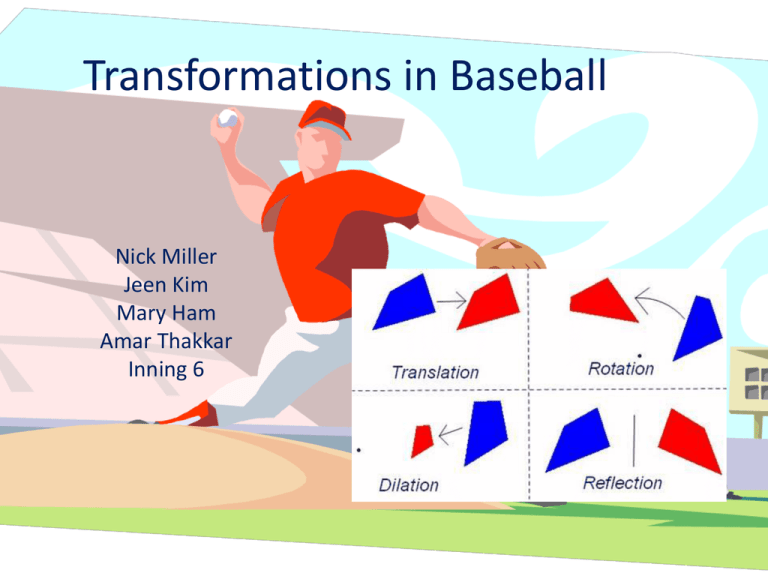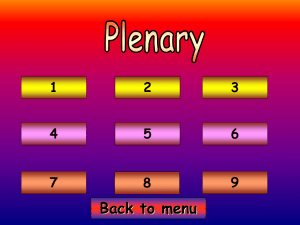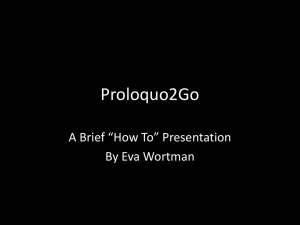Rotations - River Dell Regional School District
advertisement

Transformations in Baseball Nick Miller Jeen Kim Mary Ham Amar Thakkar Inning 6 Main Menu Dilations by Nick Miller Rotations by Jeen Kim Reflections by Mary Ham Translations by Amar Thakkar Tessellation by Group Dilations By Nicholas Miller Table of Contents Main Menu Table of Contents • • • • • • • • Dilation Scale Factor What is the Scale Factor? Matrices New Image and Preimage Theorem Problems Dilations for Baseball Main Menu Dilation • Dilation is a similarity transformation in which a figure is enlarged or reduced using a scale factor ≠ 0, without altering the center Table of Contents Main Menu Scale Factor • The amount by which an object enlarges or reduces is known as the scale factor • If the scale factor is a number of a fraction larger than 1, the new figure is an enlargement of the pre image • If the scale factor is a number or a fraction less than one, than the new figure is a reduction of the pre image Table of Contents Main Menu What is the Scale Factor? To find the scale factor, put the B’ coordinates over the pre image B coordinates: -2/-1 for x 6/3 for y They should both come out to the same thing In this case, the scale factor is 2 If you are given the scale factor in a problem, and you need to find out the coordinates either the pre image or the new figure, either multiply or divide the coordinates of the figure you already have, and you get the new coordinates Table of Contents Main Menu Matrices What you see in the top left corner of the picture is called a matrices, which gives people a better organization of finding the new coordinates In the photo, 2 is the scale factor, and you have the coordinates of the preimage Table of Contents Main Menu New Image and Preimage • In a dilation, the new image created from the preimage is similar to the preimage. • The figures would be congruent only if the scale factor is 1 Table of Contents Main Menu • If B is not the center point O, then the image point P’ lies on line CB • The scale factor k is a positive number such that k= OB’/OB and K doesn’t = 1 • If B is the center point O, then B=B Table of Contents Theorem Main Menu What are the new coordinates if the scale factor is 3? A--- (1,1) 1x3=3 1x3=3 B--- (2,3) 2x3=6 3x3=9 C--- (4,1) 4 x 3 = 12 1x3=3 Table of Contents A= (3,3) B= (6,9) C= (12,3) Main Menu B= (-2,4) D= (1,1) A= (-5,1) C= (-2,3) Table of Contents What are the coordinates of the baseball field if the scale factor is 1/3 with the center point (-2,0) Main Menu • In baseball, the field is a diamond. An example using the baseball diamond is if a little league field wanted to be renovated, and be made bigger, the dilation would be an enlargement from the little league size field to the middle school size field. Table of Contents Dilations for Baseball Main Menu Rotations By Jeen Kim Table of Contents Main Menu Rotation Table of Contents • • • • • • Rotation Vocabulary/Key Concepts Things to Know Examples Real Life Applications Activity Table of Contents Main Menu Rotation • Rotation: o A transformation where a figure is turned around a center of rotation. o A rotation is an isometry (a transformation where the figure stays congruent) Table of Contents Main Menu Vocabulary/Key Concepts • Center of Rotation: o A fixed point anywhere that the figure rotates about • Angle of Rotation: o The angle created by rays drawn from the center of rotation to a point and its image. • Theorem: o Line K and line M intersect at point P. Then a reflection in line K and the line M is a rotation about point P. o The angle of rotation is double the angle formed by K and M. • Rotational Symmetry: o A figure in the plane has rotational symmetry if the figure can be mapped onto itself by clockwise rotation of 180 degrees or less. Table of Contents Main Menu Things to Know • Angle of Rotation: – – – – R90° (x,y) = (-y, x) R180° (x,y) = (-x,-y) R270° (x,y) = (y,-x) R-90° (x,y) = (y,-x) Table of Contents Main Menu Examples • Rotational Symmetry 180° Before: After: Table of Contents Main Menu Real Life Applications • Rotations can be found in Baseball! • From the pitching mound to the bases, the base runner is the object that rotates and the pitcher is the center of rotation. The batter ran from the home plate to second base, which is a rotation of 180°. Table of Contents Main Menu Rotation Activity Rotate the shape by 60° CLOCKWISE. TIP: Use a protractor and a ruler. Table of Contents Main Menu Rotation Activity Table of Contents Main Menu Find the angle of rotation Draw the shape from the origin if the angle of rotation is 120° Table of Contents Main Menu Find the angle of rotation Draw the shape from the origin if the angle of rotation is 120° Table of Contents Main Menu Reflections By Mary Ham Table of Contents Main Menu Table of Contents • • • • • • • • Key Words What is a Reflection? Reflection How to Reflect Pre-images Determine Lines of Symmetry How to Find Line of Symmetry Line of Symmetry in Baseball Reflect Your Own Baseball! Main Menu Key Words • Line of reflection- A line that acts like a mirror in a reflection. • Line of symmetryAn imaginary line that you could fold the image and both halves match exactly. Table of Contents Line of Reflection Rectangle has 2 lines of Symmetry Main Menu What is reflection?? • Reflection is a transformation which uses a line that acts like a mirror, with an image reflected in the line. • Reflection is an isometry. – Isometry is a transformation that preserves lengths. Table of Contents Main Menu Reflection • If a figure is reflected over the y-axis, then the y value stays the same but x value becomes opposite and vice versa. If the line of reflection is yaxis, then the y value stay the same and x value become opposite. Table of Contents Main Menu How to reflect pre-images • • • • • Use the following equation: Rx-axis (x,y)=(x,-y) Ry-axis (x,y)=(-x,y) Ry=x (x,y)= (y,x) Ry=-x (x,y)= (-y,-x) Or 1. Draw the perpendicular line of the line of reflection from a point. Table of Contents Main Menu How to reflect pre-images (Cont) 2. Draw the point in the different side of line of reflection; the distance from the image and line of reflection has to be the same distance from the pre-image from the line reflection. Table of Contents Main Menu Determine Lines of Symmetry • There’s not really a way to find lines of symmetry by equation. • However, if a figure is a regular polygon, then the number of sides is equal to the number of lines of symmetry. Square Table of Contents # of sides: 4 # of lines of symmetry:4 Main Menu How to find line of reflection • 1. Find pairs of reflecting (corresponding) points. • 2. Find the midpoint of the pair of reflecting points. • 3. Connect the midpoints; the line has to be a straight line. Table of Contents Main Menu Line of Symmetry in Baseball A base ball and a baseball field have one line of symmetry Table of Contents Main Menu Reflect your own baseball • Stuff you need: Graph paper or coordinate grid, pencil, eraser, and Computer if using GSP Table of Contents 1. Draw a pre-image of a baseball that you would like to reflect on the coordinate grid. 2. Draw the line of reflection where you want to reflect the baseball. Main Menu Make your own reflection (Cont.) 3. Reflect the pre-image over the line of reflection, the shape has to be exact. 4. Then you got yourself a reflection Table of Contents Main Menu Translations By Amar Thakkar Table of Contents Main Menu Table of Contents • • • • • • Summary Vocabulary Example Solution Real World Examples GSP Activity Main Menu Summary • Translations are basically the sliding of a shape from one section to another section. On a grid you can find a translated figure if you have a coordinate notation or component form or you can find these by calculating the distance traveled x and y or y and x to find the coordinate notation or component form. Table of Contents Main Menu Vocabulary • A translation is a transformation that maps every two points P and A in the plane to points P’ and Q’, so that the following properties are true: PP’ = QQ’ and 2)’ ll ’, or and’ are collinear. Table of Contents Main Menu Vocabulary • A vector is a quantity that has both direction and magnitude, or size. • When a vector is drawn , the initial point, or starting point, of the vector is drawn point P and the terminal point, or ending point, of the vector is point Q. is read “vector PQ” Table of Contents Main Menu Vocabulary • The component form of a vector combines the horizontal and vertical components Component Form Ta,b(x,y)= (x+a) (y+b) Table of Contents Main Menu EXAMPLE • Find the coordinate notation and component form of this translation. Table of Contents Main Menu Solution • Coordinate Notation (x-5, y+3) • Component Form <-5, 3> Table of Contents Main Menu Real world Examples • When a runner runs around the bases each time he or she reaches a new base, a translation of 60 units has happened. Table of Contents Main Menu GSP Activity • Click on Graph show grid • Draw three points on the grid and connect them with line segments • Select all three sides with the cursor and copy the triangle by pressing control c • Go to another section of the grid and press control v to paste • Find the coordinate notation and component form. Table of Contents Main Menu Tessellation By Group Main Menu Table of Contents Table of Contents • • • • Tessellation by Nick Miller Vocabulary/Key Terms by Mary Ham Real Life Examples by Amar Thakkar Activity by Jeen Kim Main Menu What is a Tessellation? • A tessellation is a repeating pattern of figures that completely covers a plane without any gaps or overlaps • To tessellate is to cover a plane surface by repeated use of a single shape, without any gaps or overlapping Table of Contents Main Menu Key Terms • Tessellation- A repeating pattern of figures that completely covers a plane without any gaps or overlaps. • Edge- Intersection between two bordering tiles. • Vertex- Intersection of three or more bordering tiles. Table of Contents Main Menu Key Terms (cont) • Regular Tessellation- When a tessellation uses only one type of regular polygon to fill up a plane. • Semi-regular Tessellation- When a tessellation uses more than one type of regular polygon to fill up a plane. Regular tessellation Table of Contents Semi-regular tessellation Main Menu Real-Life Example • 4 random bases joined together form a tessellation. Table of Contents Main Menu • Use 4 regular hexagons and 6 regular triangles to create a tessellation. Tessellation Activity Table of Contents Main Menu Tessellation Activity • Example Answer: Table of Contents Main Menu LAST INNING • • • • • • Design and Editing by: Jeen Kim Dilations by: Nick Miller Rotations by: Jeen Kim Reflections by: Mary Ham Translations by: Amar Thakkar Reflections by: the Group Rotation Bibliography http://www.regentsprep.org/Regents/math/g eometry/GT4/ROTATEPIC3.gif Clip Art on Microsoft PowerPoint Blank Coordinate Plane from Mrs. Haemmerle McDougal Littell Inc. Geometry Chapter 7 Resource Book Reflection Bibliography Images Baseball 1:http://www.sullivanil.us/SYB.html Coordinate: http://www.regentsprep.org/Regents/math/ALGE BRA/MultipleChoiceReview/Shapes.html Baseball 2:http://mypixelpress.com/photobaseball-red-thread-63.html Baseball field: http://www.topendsports.com/image/clipart/bas eball/baseball-diamond-field.gif.php Tessellation Bibliography Clip Art on Microsoft Powerpoint GIFs/JPEGs http://www.beechmontyouthsports.com/images /baseball_player__runningA.gif http://www.fangraphs.com/blogs/wpcontent/uploads/2013/04/Rutledge.gif.opt_.gif http://www.fangraphs.com/blogs/wpcontent/uploads/2013/02/Berry2B.gif.opt_.gif http://2.bp.blogspot.com/SzlHhVj3i0o/UQ_E52pAMaI/AAAAAAAADZs/v3FVFHcNCY/s1600/image1.jpg



